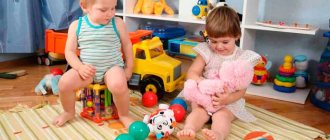Every mother wonders how to get her child interested in learning letters. After all, knowledge of letters and the ability to put them into syllables and words directly depend on the further development of the child and his performance at school. Therefore, for example, teaching letters to 5-year-old children is not only possible, but also necessary. At the same time, you should not delay the learning process, but, on the contrary, try to speed it up.
When starting to work with their baby, many mothers are faced with the problem that the child does not want to learn letters. The fact is that children, depending on their age, can remain focused for several minutes. In this connection, you need to interest and intrigue the child so much that the child will happily complete all the tasks prepared for him and look forward to the next task.
Advice: since it is almost impossible to force a child to learn letters, make sure that he wants it himself, for which you will need to prepare an educational game program on your part.
Otherwise, from the first days you will sow in the child’s soul a strong dislike for science and learning, which will not have a positive effect on his school years in the future.
At what age can you start training?
Teachers and psychologists do not have strict regulations regarding the specific age at which a preschooler can be introduced to letters. However, experts still consider five years to be the most favorable time for this. This recommendation is based on the fact that in very young children the visual-effective type of thinking predominates. But by the age of 5, the brain is already able to perceive abstract information, iconic images, which are letters.
According to psychologists, it is at this age that a child shows special curiosity and can remember a large amount of information without much effort.
In addition, before the age of 5, the speech apparatus is still developing, so the baby often cannot correctly pronounce the names of some letters. There is a chance that he will remember their incorrect sound, which will create problems in the future when learning to read.
According to psychologists and teachers, the optimal age for learning the alphabet is 5 years
Another important point. Parents need to understand that learning letters and the alphabet is closely related to learning to read. If you start getting acquainted with the alphabet too early, the baby may simply forget the letters by the time it is time to master reading (to prevent this from happening, they need to be repeated almost daily).
However, these are only general recommendations. We must not forget that each baby is individual. And some are able to perfectly master letters at the age of three, while for others this task becomes feasible only at school.
Correct introduction to Russian letters at 3 years old
By the age of three, many children already have their favorite fairy tales and books. At this age, you can only learn individual letters with your baby, and certainly not get hung up on their sequence (do not touch the alphabet).
Three-year-old children remember best the letters A, B and C, as well as the first letter of their name, M and P (“mom” and “dad”).
A three-year-old child should make or purchase toy letters - voluminous, colorful, interesting to look at. Various cubes (preferably voluminous, soft) with drawn letters and pictures will come to the aid of parents. You can choose an image of a specific theme (for example, only animals).
For a three-year-old child, it is best to associate letters with toys, for example, voluminous soft cubes
For example, as a child I had a large inflatable ball on which all the letters of the alphabet were depicted with black and red pictures. I remember that I really loved playing with it and looked at the images for a long time. My first acquaintance with letters was connected with this toy.
Mom can also lay out little letters from counting sticks, matches, buttons, and draw them on paper or with chalk on the asphalt. Then you need to encourage the baby to repeat these actions.
4 years: play and remember
The recommendations for a four-year-old child will be the same, only the adult begins to use various games for learning: dominoes, lotto, “Magic Bag”, etc.
For example, you can play the game “Find the Pictures”. Mom posts a certain letter and 3-4 pictures. Among them, the child must choose an object starting with a given letter.
In addition, you can purchase an interactive alphabet in the form of a poster or book. Toddlers usually really enjoy pressing the buttons on it. The shape of the letter will be imprinted in the child’s memory, and he will associate the graphic symbol with the sound.
The interactive alphabet will connect a graphic symbol with a picture and sound
The child can already be shown various educational cartoons, videos where the alphabet, for example, appears in the form of a funny song.
Video: the entire alphabet in the form of a funny song
5–6 years: school techniques for learning in the comfort of home
At the age of 5, you can already learn the alphabet directly, that is, the letters in their correct sequence. You need to tell your child that the alphabet is the basis of our language. Knowing it helps in life, for example, it makes it much easier to navigate the library when you need to find a book starting with a certain letter.
At this time, games and more complex productive activities (for example, plasticineography, making unconventional applications from seeds, cereals, napkins, etc., modeling) will again be of help to parents. Various manuals (printed alphabet books), special workbooks, and copybooks will come to the rescue (after all, you can not only study letters, but immediately learn to write them).
At 5–6 years old, a child can already be offered special workbooks, copybooks
In addition, there are many useful applications for smartphones and tablets. These are educational games that help you master the alphabet.
Together with your child, you can make a unique author’s primer. Take a regular album (you can glue appliqués from postcards or magazines onto the cover), draw a letter and a picture on each page—an object whose name begins with that letter. This activity will bring family members closer together and will undoubtedly captivate the preschooler.
Which method is better: Glen Doman, Montessori, Zaitsev?
— The first is known for the fact that the name of the item is attached to it, written in large block letters.
The child gradually fixes it like a written word and identifies it with a specific object. The method requires parental patience and regular practice. Zaitsev's method is interesting because, unlike Glen Doman's system, it suggests the use of cubes. At one time, many different cubes with letters were produced, which gave a general understanding of the alphabet. But the disadvantage was that these were separate letters, from which it was difficult to form a word. Zaitsev's cubes selected according to frequency of use in the language. Each kit comes with special instructions that explain to parents how learning should take place. This technique takes into account the characteristics of the child. Everything is thought out here, from letter sizes and colors, and various analyzers are used. In addition, Zaitsev’s technique does not stand still, it is evolving.
The disadvantage of teaching reading using whole words is that the child uses his abilities only as a photographer. Attention, concentration, and memory are involved. And Zaitsev’s cubes also contain thinking, emotions, and feelings. Because the child acts as the initiator of the collection, and this is much more interesting and natural for her.
However, why do we want to choose only one technique? I'm not sure this will work. Synthesis of several methods is possible. In addition, parents will receive the desired effect only if the activities are systematic and enjoyable for the child.
Where do the cons come from?
In what order should I learn the letters?
The basic way to learn the alphabet is to use letter cards (they can be supplemented with pictures). You can choose the following algorithm:
- First, it is better to master all the vowels; it is convenient to do this in pairs: A - Z, O - E, U - Yu, Y - I, E - E).
- Then consonants are introduced, first paired in terms of voicedness and voicelessness (B - P, V - F, Z - S, etc.), then unpaired.
- At the end, you should introduce the child to b and b.
- Only after studying all the letters should you move on to the alphabet - their correct sequence.
However, when learning letters, it is better to name the sounds they represent, rather than how the letters are pronounced in the alphabet. This will make learning to read easier in the future.
Glen Doman Method
It arose back in the 40s of the 20th century, when the American neurophysiologist Glen Doman began developing a rehabilitation program for children with lesions of the nervous system. The idea is that the child learns to read words immediately, and not letter by letter. To do this, parents write in red on rectangular cards in large block letters the names of objects that the child often sees. You can find ready-made cards for sale. Then they show these cards to the child many times, while simultaneously saying the word. In addition, mom or dad simultaneously show the object, which is called this word. The child remembers what he saw and heard and subsequently begins to read himself. Gradually the number of cards increases, and therefore the number of words increases.
Tips for parents on organizing classes
In order for a child to learn the alphabet with interest and pleasure, it is important to correctly organize home lessons, which in no case should tire you. A simple rule applies - it is better often, but little by little, so that the preschooler looks forward to the next lesson, and does not get tired, repeating the same thing. In addition, you should adhere to the following simple recommendations:
- Only game form.
- An atmosphere of fun and goodwill should reign in ABC lessons.
- The child should be praised for any success; there is no need to scold him at all.
- The short duration of training is compensated by their frequency. You can practice for 10 minutes, even 2-3 times a day, if the child is ready for this and shows interest.
- Use a variety of techniques and games to keep things interesting.
- A clear example should always be before your eyes; in preschool age, the role of involuntary memorization is great, so you should, together with your child, choose in the store or make with your own hands a bright colorful poster with the alphabet, which should be hung in a prominent place in the nursery.
- Use associations. The letters “F” and “Z” do not say anything to the child, but the images of “a toad and a snake who are friends, that’s why the letters are nearby” will be deposited in the head, and accordingly, part of the sequence will be remembered.
It is important for parents to do everything so that their kids do not lose interest; their memory is very flexible, so if they play with letters, they will quickly remember their location. But regaining lost interest in studying is much more difficult.
Unconventional ways to learn the alphabet
Parents do not have to adhere to the well-known classical methods of introducing the alphabet. Games can be created based on the interests, desires and favorite activities of your unique child. You can learn letters in the most unconventional ways:
- Shape from dough and bake. During the cooking process, play with each element, remember the appropriate rhyme or sing a song with your child.
- Place the food on a plate and present it to the child during meals. Let him remember and name the letter on his own.
- Construct from various available materials: sticks, twigs, buttons or ropes.
- Come up with and draw a funny Letter Eater on a piece of paper. Instead of a mouth, make a hole into which, at the character’s request, you can put the letters drawn on plastic bottle caps or beans.
- “Cook” them into food for the dolls, naming each “ingredient” that goes into the saucepan.
- Play hide and seek with the letters: find their image in a picture with many small details, find a specific letter among others, or return lost toy animals to the house with the corresponding sign.
Interestingly, you can learn the alphabet even during outdoor games, which will undoubtedly appeal to beginning students. To do this, you need to hang colorful signs on the walls and give the child the command “Run to the letter m, and now to y.” If there are several children, then you can organize real sports competitions with prizes, and rest assured, this knowledge will definitely remain in the memory of your student.











